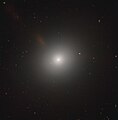Fichier:Messier105 - HST - Potw1901a.jpg

Taille de cet aperçu : 591 × 599 pixels. Autres résolutions : 237 × 240 pixels | 473 × 480 pixels | 758 × 768 pixels | 1 010 × 1 024 pixels | 2 020 × 2 048 pixels | 7 572 × 7 676 pixels.
Fichier d’origine (7 572 × 7 676 pixels, taille du fichier : 15,83 Mio, type MIME : image/jpeg)
Historique du fichier
Cliquer sur une date et heure pour voir le fichier tel qu'il était à ce moment-là.
| Date et heure | Vignette | Dimensions | Utilisateur | Commentaire | |
|---|---|---|---|---|---|
| actuel | 7 janvier 2019 à 07:23 |  | 7 572 × 7 676 (15,83 Mio) | Fabian RRRR | == {{int:filedesc}} == {{Information |description={{en|1=''' The heart of the Lion The heart of the Lion It might appear featureless and unexciting at first glance, but NASA/ESA Hubble Space Telescope observations of this elliptical galaxy — known as Messier 105 — show that the stars near the galaxy’s centre are moving very rapidly. Astronomers have concluded that these stars are zooming around a supermassive black hole with an estimated mass of 200 million Suns! This black hole releases hug... |
Utilisation du fichier
Les 2 pages suivantes utilisent ce fichier :
Usage global du fichier
Les autres wikis suivants utilisent ce fichier :
- Utilisation sur ar.wikipedia.org
- Utilisation sur az.wikipedia.org
- Utilisation sur be-tarask.wikipedia.org
- Utilisation sur bn.wikipedia.org
- Utilisation sur ca.wikipedia.org
- Utilisation sur ce.wikipedia.org
- Utilisation sur ckb.wikipedia.org
- Utilisation sur cs.wikipedia.org
- Utilisation sur de.wikipedia.org
- Utilisation sur diq.wikipedia.org
- Utilisation sur en.wikipedia.org
- Utilisation sur es.wikipedia.org
- Utilisation sur et.wikipedia.org
- Utilisation sur eu.wikipedia.org
- Utilisation sur hu.wikipedia.org
- Utilisation sur id.wikipedia.org
- Utilisation sur it.wikipedia.org
- Utilisation sur mg.wikipedia.org
- Utilisation sur mk.wikipedia.org
- Utilisation sur no.wikipedia.org
- Utilisation sur simple.wikipedia.org
- Utilisation sur tt.wikipedia.org
- Utilisation sur vi.wikipedia.org
- Utilisation sur www.wikidata.org
- Utilisation sur zh-yue.wikipedia.org

